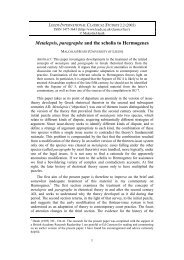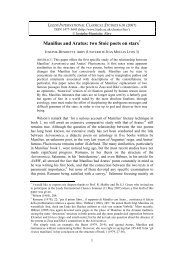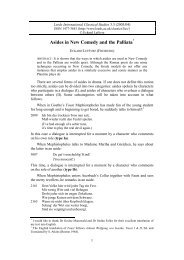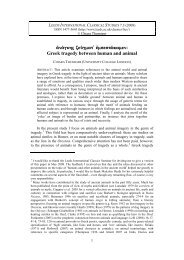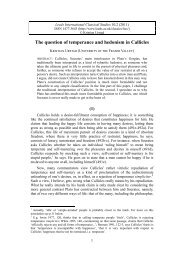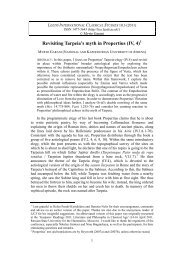The New Posidippus - Leeds International Classical Studies
The New Posidippus - Leeds International Classical Studies
The New Posidippus - Leeds International Classical Studies
You also want an ePaper? Increase the reach of your titles
YUMPU automatically turns print PDFs into web optimized ePapers that Google loves.
MARY FRANCES WILLIAMS, THE NEW POSIDIPPUS<br />
3.2 <strong>Posidippus</strong> X.16-25 = 63 AB<br />
tÒnde Fil…tai c[al]kÕn [‡]son kat¦ p£n'{a} `Ek[a]ta‹oj<br />
¢]k[r]ib¾j ¥krouj [œpl]asen e„j Ônucaj,<br />
kaˆ me]gšqei ka[ˆ sa]rkˆ tÕn ¢nqrwpistˆ dièxaj<br />
gnèmo]n', ¢f' ¹rèwn d' oÙd n œmeix'{e} „dšhj,<br />
¢ll¦ tÕn ¢kromšrimnon Ól[hi k]atem£xato tšcnhi<br />
pr]šsbun, ¢lhqe„hj ÑrqÕn [œcwn] kanÒna:<br />
aÙd»s]onti d' œoiken, Óswi poik…lletai ½qei,<br />
œmyuc]oj, ka…per c£lkeoj ën Ð gšrwn:<br />
k Ptole]ma…ou d' ïde qeoà q' ¤ma kaˆ basiloj<br />
¥gkeit]ai Mousš{i}wn e†neka Kîioj ¢n»r.<br />
Hecataeus, working with great accuracy right down to the extremities of the<br />
nails, following the human measure as to both size and skin, fashioned this<br />
bronze statue equal in size to Philitas in every detail, and mixed in nothing from<br />
the type of heroes. Rather, he has brought to completion with the entirety of his<br />
art and holding the real canon of truth, the elder who devoted himself to<br />
perfection. And although the old man is made of bronze, such is the subtlety of<br />
character with which he is depicted that he looks like one alive, as if about to<br />
speak. And the Coan man is set up here by the grace of Ptolemy, at once god and<br />
king, for the sake of the Muses. 95<br />
<strong>Posidippus</strong> praises Hecataeus’ bronze sculpture of Philitas of Cos for its<br />
realistic accuracy (Pos. X.17) and he also notes the statue’s ‘size and flesh’,<br />
intelligent expression, human proportions, and character (X.18-22). <strong>The</strong> statue<br />
seems to be alive (X.23) and even appears ‘about to speak’ (X.22). <strong>Posidippus</strong><br />
distinguishes between modern art and older artists: the statue ‘owes nothing to the<br />
heroic’ (i.e., idealized) style (¢f' ¹rèwn d' oÙd n X.19).<br />
<strong>Posidippus</strong> indicates his familiarity with the technical vocabulary of sculpture<br />
by his mention of ‘accuracy’ (¢]k[r]ib¾j X.17). Akribeia was a technical term in<br />
fourth-century art criticism, 96 and Lysippus was praised for his akribeia. 97<br />
Accuracy was prized by Polycleitus, who said, ‘the work is hardest when the clay<br />
comes to the fingernail’, 98 a phrase <strong>Posidippus</strong> echoes when he mentions<br />
fingertips (¥krouj [œpl]asen e„j Ônucaj Pos. X.17). 99 <strong>Posidippus</strong>’ emphasis on<br />
Hecataeus’ interest in human proportions (tÕn ¢nqrwpistˆ dièxaj gnèmo]n' Pos.<br />
X.18-19) suggests the proportionality of both Polycleitus and Lysippus. 100 Also,<br />
<strong>Posidippus</strong>’ stress on the finish of bronzes (sa]rkˆ Pos. X.18; cf. s£rkina Pos.<br />
XI.17) refers to sculptural practice since sculptors, particularly Polycleitus and<br />
95<br />
Translated Hardie (2003) 27. Cf. Scodel (2003) 44.<br />
96<br />
Arist. Poet. 4, 1448b10-12. Pollitt (1974) 22. Polycleitus was also noted for his akribeia (Galen,<br />
De Temperamentis i.566; Stewart (1978b) 125).<br />
97<br />
Stewart (1990) 21, 63, 299; T124 = Plin. NH 34.61-5.<br />
98<br />
Stewart (1990) I, 25, 161; T67 = Plut. Mor. 86a, 636b-c; 40B1 Diels-Kranz.<br />
99<br />
So also Hardie (2003) 35.<br />
100<br />
Lysippus’ new style of bronze sculpture was characterized by attention to detail, great height,<br />
and symmetria of the human body (Stewart (1990) I, 291; T124 = Plin. NH 34.61-5, who infers<br />
that Xenocrates was Pliny’s source).<br />
12



